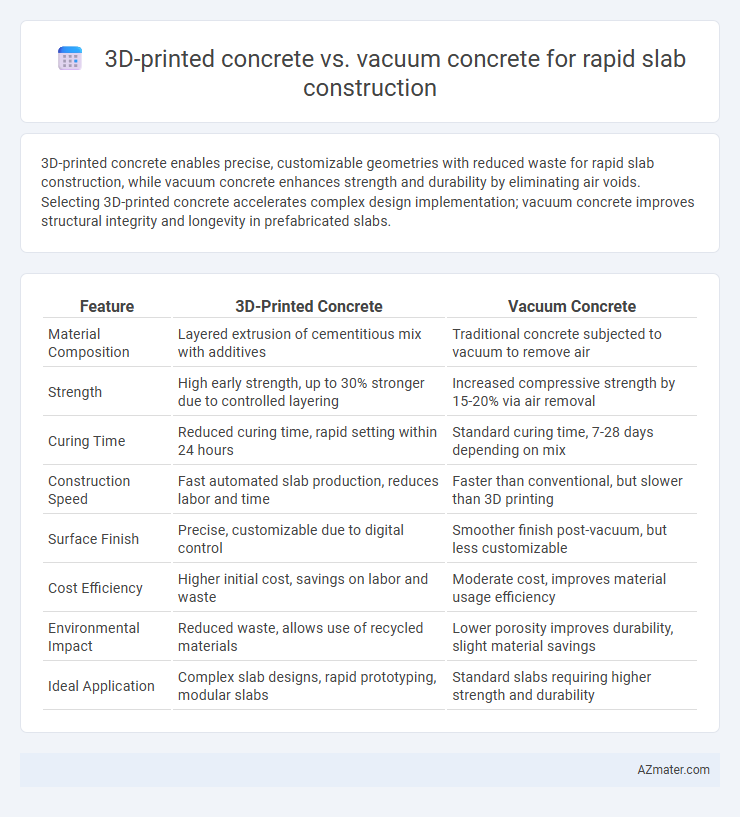3D-printed concrete enables precise, customizable geometries with reduced waste for rapid slab construction, while vacuum concrete enhances strength and durability by eliminating air voids. Selecting 3D-printed concrete accelerates complex design implementation; vacuum concrete improves structural integrity and longevity in prefabricated slabs.
Table of Comparison
| Feature | 3D-Printed Concrete | Vacuum Concrete |
|---|---|---|
| Material Composition | Layered extrusion of cementitious mix with additives | Traditional concrete subjected to vacuum to remove air |
| Strength | High early strength, up to 30% stronger due to controlled layering | Increased compressive strength by 15-20% via air removal |
| Curing Time | Reduced curing time, rapid setting within 24 hours | Standard curing time, 7-28 days depending on mix |
| Construction Speed | Fast automated slab production, reduces labor and time | Faster than conventional, but slower than 3D printing |
| Surface Finish | Precise, customizable due to digital control | Smoother finish post-vacuum, but less customizable |
| Cost Efficiency | Higher initial cost, savings on labor and waste | Moderate cost, improves material usage efficiency |
| Environmental Impact | Reduced waste, allows use of recycled materials | Lower porosity improves durability, slight material savings |
| Ideal Application | Complex slab designs, rapid prototyping, modular slabs | Standard slabs requiring higher strength and durability |
Introduction to Rapid Slab Construction Technologies
Rapid slab construction technologies prioritize fast, efficient building processes using innovative materials and methods. 3D-printed concrete offers precise layer-by-layer fabrication, reducing waste and allowing complex designs with minimal labor. Vacuum concrete enhances curing speed and strength through controlled air removal, enabling quicker slab setting and improved durability in time-sensitive projects.
Overview of 3D-Printed Concrete Methods
3D-printed concrete methods utilize layered deposition techniques to build intricate slab designs with high precision, improving material efficiency and reducing waste compared to traditional casting. These methods leverage advanced robotics and computer-aided design (CAD) to create complex geometries that enhance structural performance and enable faster construction timelines. 3D printing technology also allows for customization in mix design, incorporating additives for increased durability, shrinkage control, and faster curing rates suitable for rapid slab construction.
Fundamentals of Vacuum Concrete Process
The Vacuum Concrete Process enhances slab construction by using a vacuum system to rapidly extract excess water and air from the fresh concrete mix, accelerating setting time and improving early strength gain. This method creates a denser, more durable concrete with reduced porosity compared to traditional 3D-printed concrete, which relies on layer-by-layer extrusion without dewatering. Vacuum concrete technology optimizes curing efficiency and structural performance, making it highly suitable for rapid slab installation in construction projects.
Comparison: Speed of Construction
3D-printed concrete significantly accelerates rapid slab construction by enabling automated layer-by-layer deposition, reducing formwork requirements and labor time compared to traditional methods. Vacuum concrete, while improving curing rates and reducing moisture content, does not match the continuous, precise application speed achievable with 3D printing technology. Consequently, 3D-printed concrete offers superior construction speed advantages, especially in complex or large-scale slab projects.
Material Properties and Structural Performance
3D-printed concrete offers enhanced precision and customization with improved bonding characteristics and reduced material waste, making it ideal for complex slab geometries. Vacuum concrete exhibits superior density and compressive strength due to air extraction during curing, resulting in higher durability and load-bearing capacity for rapid slab construction. Both materials demonstrate distinct advantages; 3D printing excels in design flexibility, while vacuum concrete ensures optimal structural integrity and faster construction cycles.
Sustainability and Environmental Impact
3D-printed concrete significantly reduces construction waste and material usage by precisely depositing layers, enhancing sustainability in rapid slab construction. Vacuum concrete improves durability and reduces porosity, leading to longer-lasting structures with lower maintenance needs, thereby minimizing environmental impact over time. Both technologies contribute to eco-friendly building practices by optimizing resource efficiency and reducing carbon footprints in slab production.
Cost Analysis: 3D-Printed vs Vacuum Concrete
3D-printed concrete reduces labor costs by automating the slab construction process, leading to faster project completion and lower overall expenses compared to vacuum concrete, which requires intensive manual labor and specialized equipment. Material costs for 3D printing are optimized through precise layering, minimizing waste, whereas vacuum concrete demands higher energy consumption and additional machinery for air removal, increasing operational costs. Maintenance and equipment investment for vacuum concrete dramatically surpass those of 3D-printed systems, making 3D printing a more cost-effective solution in rapid slab construction projects.
Applications and Suitability in Modern Projects
3D-printed concrete excels in complex architectural forms and rapid on-site fabrication, making it ideal for customized and intricate slab designs in modern projects requiring precision and automation. Vacuum concrete, with its enhanced compaction and reduced porosity, offers superior strength and durability, suitable for high-load, industrial slab applications where structural performance is critical. Both methods improve construction speed, but 3D printing prioritizes design flexibility, while vacuum concrete emphasizes enhanced material properties for heavy-duty slabs.
Challenges and Limitations of Each Method
3D-printed concrete faces challenges including limited material flowability and nozzle clogging, which can affect print quality and structural integrity in rapid slab construction. Vacuum concrete presents limitations such as higher equipment costs and the need for precise vacuum pressure control to avoid voids and ensure uniform compaction. Both methods require specialized expertise and have scalability constraints, impacting their widespread adoption in fast-paced construction environments.
Future Trends in Rapid Slab Construction Technologies
Future trends in rapid slab construction emphasize the advancement of 3D-printed concrete technology, which enables precise layer-by-layer deposition, reducing material waste and construction time compared to traditional methods. Vacuum concrete techniques are evolving to enhance concrete density and strength by removing entrapped air, supporting faster curing and improved slab durability in rapid construction. Integration of automation, real-time monitoring, and sustainable materials in both 3D printing and vacuum concrete processes points to increased efficiency and environmental benefits in future rapid slab construction projects.

Infographic: 3D-printed concrete vs Vacuum concrete for Rapid slab construction
 azmater.com
azmater.com